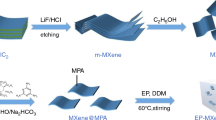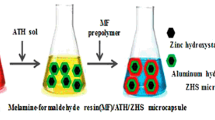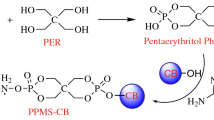Abstract
Although research on halogen free flame retardant has achieved great progress, its practical application is restricted due to high additive amount and low efficency. To solve this problem, multilayers microcapsule [melamine–formaldehyde resin (MF)/silicon dioxide (SiO2)/zinc hydroxystannate (ZHS)] was prepared through a two-step method. Moreover, when 16.40 wt% SiO2/ZHS microcapsules was mixed with poly(vinyl chloride) (PVC) matrix, the obtained PVC composites exhibited a high limited oxygen index (LOI) of 32.5%, showing its excellent flame retardancy. Furthermore, for the compatibility between MF/SiO2/ZHS microcapsules and PVC to be improved, MF was coated to SiO2/ZHS microcapsules by in situ polymerization. When 16.40 wt% MF/SiO2/ZHS microcapsules were mixed with PVC matrix, the obtained PVC composites exhibited a high LOI of 35.5%, showing its high flame retardancy. Therefore, this easily prepared multilayers microcapsule with sufficient flame retardancy in this work, it could have a potential for engineering applications.

Taking advantage of microencapsulation strategy to fabricate MF/SiO2/ZHS microcapsules for fire-retardant PVC materials
Similar content being viewed by others
Change history
18 June 2019
The authors have retracted this article (1) because the data are unreliable.
18 June 2019
The authors have retracted this article (1) because the data are unreliable. After publication, the authors found that the preparation of the SiO2/ ZHS and the MF/ SiO2/ ZHS microcapsules is not reproducible and therefore the mechanical properties and the flame retardancy properties described are incorrect.
18 June 2019
The authors have retracted this article (1) because the data are unreliable. After publication, the authors found that the preparation of the SiO2/ ZHS and the MF/ SiO2/ ZHS microcapsules is not reproducible and therefore the mechanical properties and the flame retardancy properties described are incorrect.
References
Li B (2001) An investigation of the smoke suppression and the thermal degradation in the smouldering mode of poly (vinyl chloride) containing a combination of cuprous oxide and molybdenum trioxide. Polym Degrad Stab 74:195–199
Marongiu A, Faravelli T, Bozzano G, Dente M, Ranzi E (2003) Thermal degradation of poly(vinyl chloride). J Analy Appl Pyroly 70:519–553
Xu J, Zhang C, Qu H, Tian C (2005) Zinc hydroxystannate and zinc stannate as flame-retardant agents for flexible poly(vinyl chloride). J Appl Polym Sci 98:1469–1475
Li B (2002) A study of the thermal decomposition and smoke suppression of poly(vinyl chloride) treated with metal oxides using a cone calorimeter at a high incident heat flux. Polym Degrad Stab 8:349–356
Lu H, Hu Y, Yang L, Wang Z, Chen Z, Fan W (2004) Study of the fire performance of magnesium hydroxide sulfate hydrate whisker flame retardant polyethylene. Macromol Mater Eng 289:984– 989
Liodakis S, Bakirtzis D, Dimitrakopoulos A P (2003) Autoignition and thermogravimetric analysis of forest species treated with fire retardants. Thermo Acta 399:31–42
Liang S, Neisius N M, Gaan S (2013) Recent developments in flame retardant polymeric coatings. ProgOrgaCoat 76:1642–1665
Wu N, Yang R (2011) Effects of metal oxides on intumescent flame-retardant polypropylene. Polym Adv Technol 22:495–501
Feng F, Qian L (2014) The flame retardant behaviors and synergistic effect of expandable graphite and dimethyl methylphosphonate in rigid polyurethane foams. Polym Comp 35:301–309
Chen X, Jiao C (2011) Flame retardancy and thermal degradation of intumescent flame retardant polypropylene material. Polym Adv Technol 22:817–821
Seefeldt H, Braun U (2012) A new flame retardant for wood materials tested in wood-plastic composites. MacromolMater Eng 297:814–820
Tai Q, Shan X, Song L, Lo S, Yuen RKK, Hu Y (2014) A polymeric flame retardant and surfactant-free montmorillonite nanocomposites: Preparation and exfoliation mechanism discussion. Polym Comp 35:167–173
Gao Y, Wu J, Wang Q, Wilkie C, O’Hare D (2014) Flame retardant polymer/layered double hydroxide nanocomposites. J Mater Chem A 2:10996–11016
Bradman A, Castorina R, Gaspar F, Nishioka M, Colón M, Weathers W, Egeghy PP, Maddalena R, Williams J, Jenkins PL, Mckone TE (2014) Flame retardant exposures in California early childhood education environments. Chemosphere 116:61–66
Yu L, Chen L, Dong LP, Li LJ, Wang YZ (2014) Organic–inorganic hybrid flame retardant: preparation, characterization and application in EVA. Rsc Adv 4:17812–17821
Wang B, Sheng H, Shi Y, Hu W, Hong N, Zeng W, Ge H, Yu X, Song L, Hu Y (2015) Recent advances for microencapsulation of flame retardant. Polym DegradStab 113:96–109
Hua G, Gang T, Hu W Z, Wang BB, Pan Y, Song L, Hu Y (2015) Aluminum hypophosphite microencapsulated to improve its safety and application to flame retardant polyamide 6. J Hazard Mater 294:186–194
Wu W, Qu H, Li Z, Yuan H (2008) Thermal behavior and flame retardancy of flexible poly(vinyl chloride) treated with zinc hydroxystannate and zinc stannate. J VinylAdd Techn 14:10–15
Su X, Yi Y, Tao J, Qi H (2012) Synergistic effect of zinc hydroxystannate with intumescent flame-retardants on fire retardancy and thermal behavior of polypropylene. Polym Degrad Stab 97:2128–2135
Ning Y, Guo S (2015) Flame-retardant and smoke-suppressant properties of zinc borate and aluminum trihydrate-filled rigid PVC. J Appl Polym Sci 77:3119–3127
Basfar AA (2002) Flame retardancy of radiation cross-linked poly(vinyl chloride) (PVC) used as an insulating material for wire and cable. Polym Degrad Stab 77:221–226
Giraud S, Salaün F, Bedek G, Vroman I, Bourbigot S (2010) Influence of chemical shell structure on the thermal properties of microcapsules containing a flame retardant agent. Polym Degrad Stab 95:315–319
Salaün F, Creach G, Rault F, Almeras X (2013) Thermo-physical properties of polypropylene fibers containing a microencapsulated flame retardant. Polym Adv Technol 24:236–248
Wang N, Wu Y, Mi L, Zhang J, Li X, Fang Q (2014) The influence of silicone shell on double-layered microcapsules in intumescent flame-retardant natural rubber composites. J ThermAnaly Calorimetry 118:349–357
Zhang M, Wang S, Wang C, Li J (2012) A facile method to fabricate superhydrophobic cotton fabrics. ApplSurfSci 261:561–566
Shi Y, Wang Y, Feng X, Yue G, Yang W (2012) Fabrication of superhydrophobicity on cotton fabric by sol–gel. Appl Surf Sci 258:8134–8138
Wang D, Zhang QJ, Zhou KQ, Yang W, Hu Y, Gong XL (2014) The influence of manganese-cobalt oxide/graphene on reducing fire hazards of poly(butylene terephthalate). J Hazard Mater 278:391–400
Author information
Authors and Affiliations
Corresponding author
Additional information
The authors have retracted this article because the data are unreliable. After publication, the authors found that the preparation of the SiO~2/~ ZHS and the MF/ SiO~2~/ ZHS microcapsules is not reproducible and therefore the mechanical properties and the flame retardancy properties described are incorrect. All authors agree to this retraction.
About this article
Cite this article
Zhang, B., Jiang, Y. & Han, J. RETRACTED ARTICLE: Preparation of Multilayers Zinc Hydroxystannate Microcapsules and its Application in Flame-Retardant PVC Composites. Silicon 10, 2845–2854 (2018). https://doi.org/10.1007/s12633-018-9824-1
Received:
Accepted:
Published:
Issue Date:
DOI: https://doi.org/10.1007/s12633-018-9824-1




